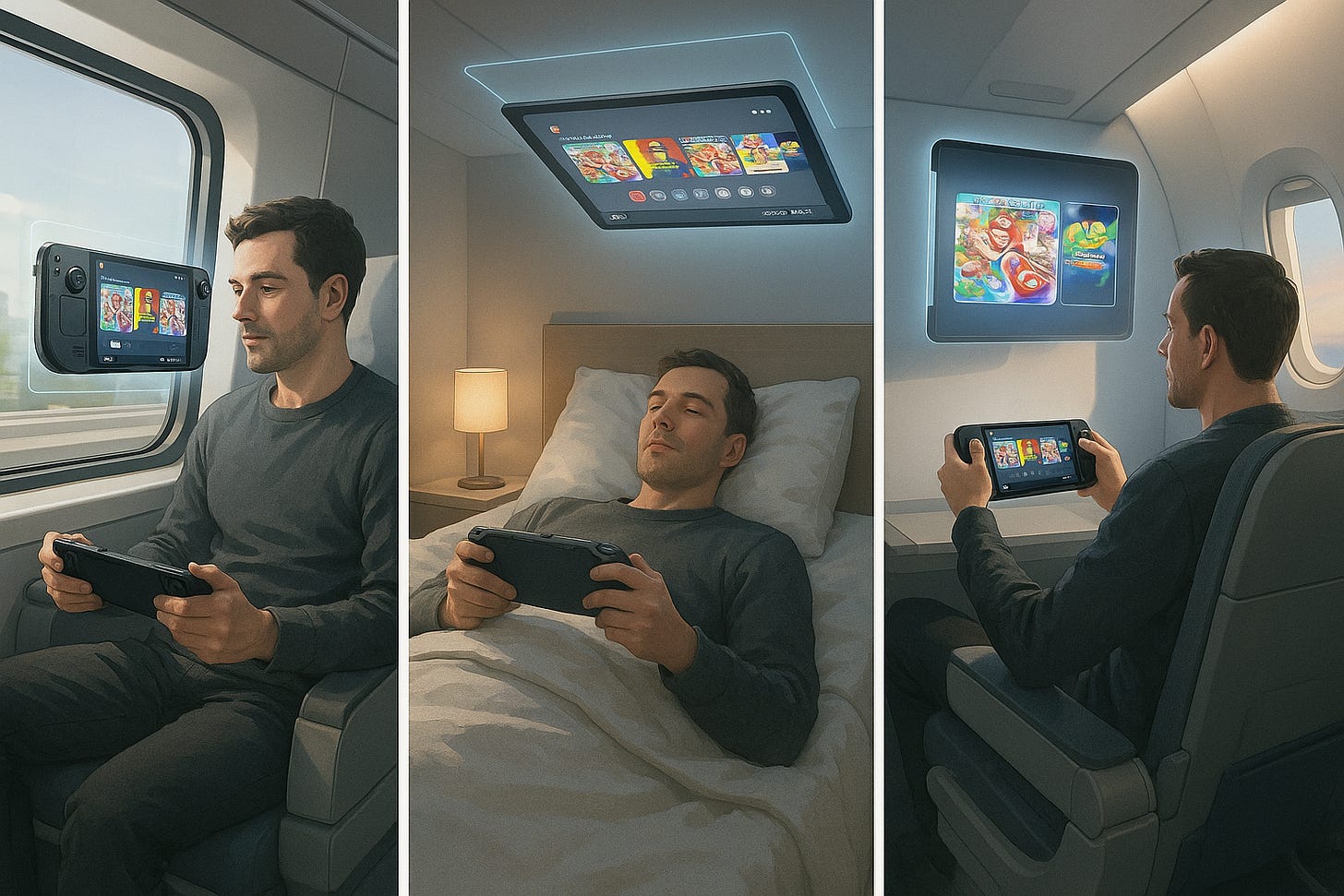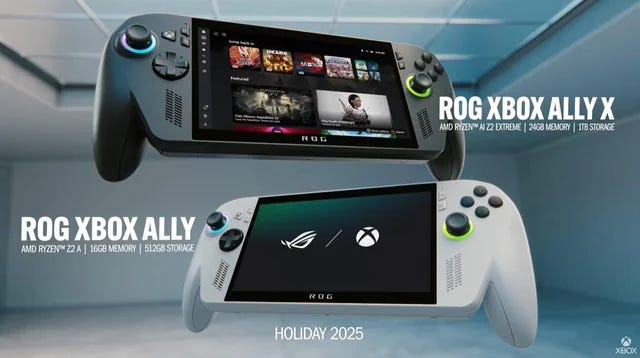Why portable gaming is reshaping tech and entertainment
Handhelds like the Switch 2, Steam Deck, PlayStation Portal, and ROG Xbox Ally X, along with the economic conditions surrounding them, are driving a broader shift in how games fit into daily life.
I've been thinking a lot about portable gaming lately, not just as a player but as someone curious about how these devices are reshaping our relationship with games.
Over the past year or so, I've been switching between numerous handheld gaming devices, including Valve's Steam Deck, Sony's PlayStation Portal (reviewed here), and now the Nintendo Switch 2. They're three very different interpretations of what "portable" can mean, each with its own logic, limitations, and strengths.
But they all share something that's quietly become the new norm: continuity, or the ability to pick up where you left off seamlessly, instantly, and wherever you are. Sometimes it's through cloud saves and sometimes through remote play. Sometimes, as with the Switch, you can just grab the hardware and walk out the door.

That new norm matters beyond gaming as well. The launch of these handhelds coincides with a period of global challenges for next-gen hardware, including U.S. tariffs, inflation, and tighter supply chains. Creating a fresh console with cutting-edge specs isn't as easy or cheap as it used to be. It's a reminder that hardware cycles are flattening, and value is now being built through ecosystem and experience innovations.
There's something fascinating about how we got here. Yes, there were the Game Boy, Sega Game Gear, and others. Still, this latest evolution didn't truly take off until the first Nintendo Switch showed there was demand for console-quality gaming that didn't require being tethered to the couch (even if the graphics weren't necessarily “next gen”). That evolution accelerated as supply chains improved and Moore's Law continued to physically shrink powerful components.
At the time, the Switch felt like a gamble: a hybrid console that could be docked for TV play or undocked for handheld use. However, in hindsight, it served as a catalyst. It reshaped how we think about time, place, and flexibility in games, and even redefined what a console could be, to the point that others now want in.
The Switch 2 builds on that foundation and sharpens it. I've had mine since launch day, and the improvements are subtle but meaningful. Titles like Cyberpunk 2077, Fast Fusion, and Mario Kart World are noticeably modern, smoother, and more vibrant, while upgrades to original Switch games are welcomed.
The device itself feels premium yet playful, boasting a larger, brilliantly colored screen (even without OLED), a refined chassis, firmer buttons, and Joy-Con rails that cling like magnets. Nintendo didn't chase raw specs here, but it focused on refining the experience. That's why launching, undocking, and continuing a game feels effortless.
Seamless continuity isn't just user-friendly, it's strategic. In an era where semiconductors are expensive, freight is volatile, and geopolitical shifts are impacting global trade, hardware manufacturers are facing fundamental limitations in upgrading their hardware. Game prices have also increased across platforms more broadly. In short, gaming is starting to feel like a luxury for some players, prompting companies to innovate elsewhere, such as in ecosystems, continuity, and convenience.
Some of that innovation may come from AI itself. Sony and others are exploring how future consoles could use AI to handle things like graphics upscaling and real-time enhancements, potentially extending the life of hardware and reducing the need for frequent spec bumps. This shift in focusing on more than just hardware isn't just a trend, but a fundamental change in how the industry moves forward.
That brings me to Microsoft's upcoming ROG Xbox Ally X, co-developed with ASUS. Announced in June and expected to start pre-orders in August with a holiday release window, it's a Windows-based handheld built around Xbox Game Pass, but it's also more than that.
You can install and play games natively from Steam, Epic Games Store, GOG, Battle.net, and Ubisoft Connect, and you also have access to streaming services like GeForce Now or even a full Shadow PC desktop experience. Want Xbox titles via Game Pass or Xbox Play Anywhere? Got it. Want to mod your PC games or use PC-only exclusive titles? Also there. Need Discord for chat or Edge to stream or browse? Install and go. Fundamentally, Microsoft is betting that players want a true "one-device-to-rule-them-all" experience: full, cross‑platform access wherever they happen to be.
This isn't a niche product. It's a strategic statement. The "This is an Xbox" campaign is less about a box and more about a vision of gaming as a service and presence. An Xbox is no longer the physical hardware under your TV — it's your username, your identity, your library, wherever you are.
Of course, the new Xbox direction and campaign haven’t been without their complaints, mainly centered around concerns about brand dilution and the potential loss of core players due to platform agnosticism. But, as player behavior evolves, the shift reinforces a broader direction for the industry.
Meanwhile, Valve’s Steam Deck stands as another pioneer of this space. It sparked the current wave of PC handhelds with an estimated 3.7 to 4 million units sold since 2022, while Sony has shipped roughly 2 million PlayStation Portals, or close to a 3% attach rate among PS5 owners, as of December 2024. These are modest numbers compared to Nintendo's dominance, but they show momentum.
For context, the Switch 2 sold over 3.5 million units in just four days, which was the biggest console launch in video game history, and is projected to outsell the existing PC handheld market in its first year (Nintendo has sold around 150 million Switch units in its lifetime).
This isn't a competition of specs, it's a contest of ecosystems, accessibility, and context. Each device sends the same signal: portable gaming is no longer a niche but a core pillar of how and where people play. These sales figures aren't just impressive, they're a testament to the power and popularity of portable gaming.
We've come a long way in asking what "portable" means. The PlayStation Portal delivers remote play from PS5, the Steam Deck combines local installs with cloud-synced saves, the Switch offers physical flexibility, and ROG Xbox Ally X promises platform-agnostic access. Each hits a different balance, but collectively, they're responding to the same truth: hardware alone isn't enough in an era where supply chains are strained and tariffs loom.
So, what defines a gaming console today? Is it raw power or visual fidelity, both of which are increasingly expensive to push further? Or is it access, identity, and invisibility? Not in the sense of going unnoticed, but in the sense that it works so intuitively that you stop thinking about it.
For me, it means more moments of play in more places. On the couch with my wife and dog while something else is on. In an airport lounge. On a subway. In a hotel room. I don't worry about save files. I don't worry about which device I'm on. The tech bends to fit my life, not the other way around.
And that's where this all points: to a future where gaming isn't about specs, it's about freedom. About reclaiming time, space, and agency in how we play. Maybe gaming’s next frontier isn’t about chasing performance. Maybe it’s about chasing freedom.
And in that race, portable is king.





I think the shift to portability and a full suite experience regardless of location (or device) applies more generally across the technology spectrum too: cloud storage and productivity solutions like M365 or Google Workspace have completely changed how we get things done at work, and in private, these days. It fits then that this mindset would also cross over into gaming. Excited to see where this will lead!